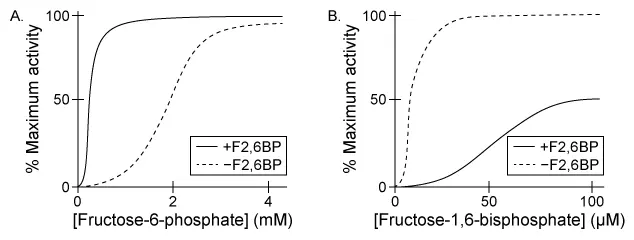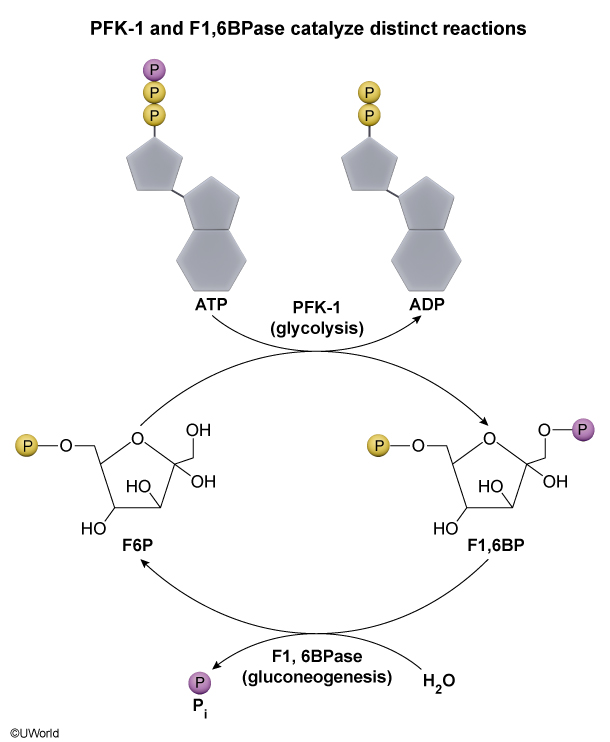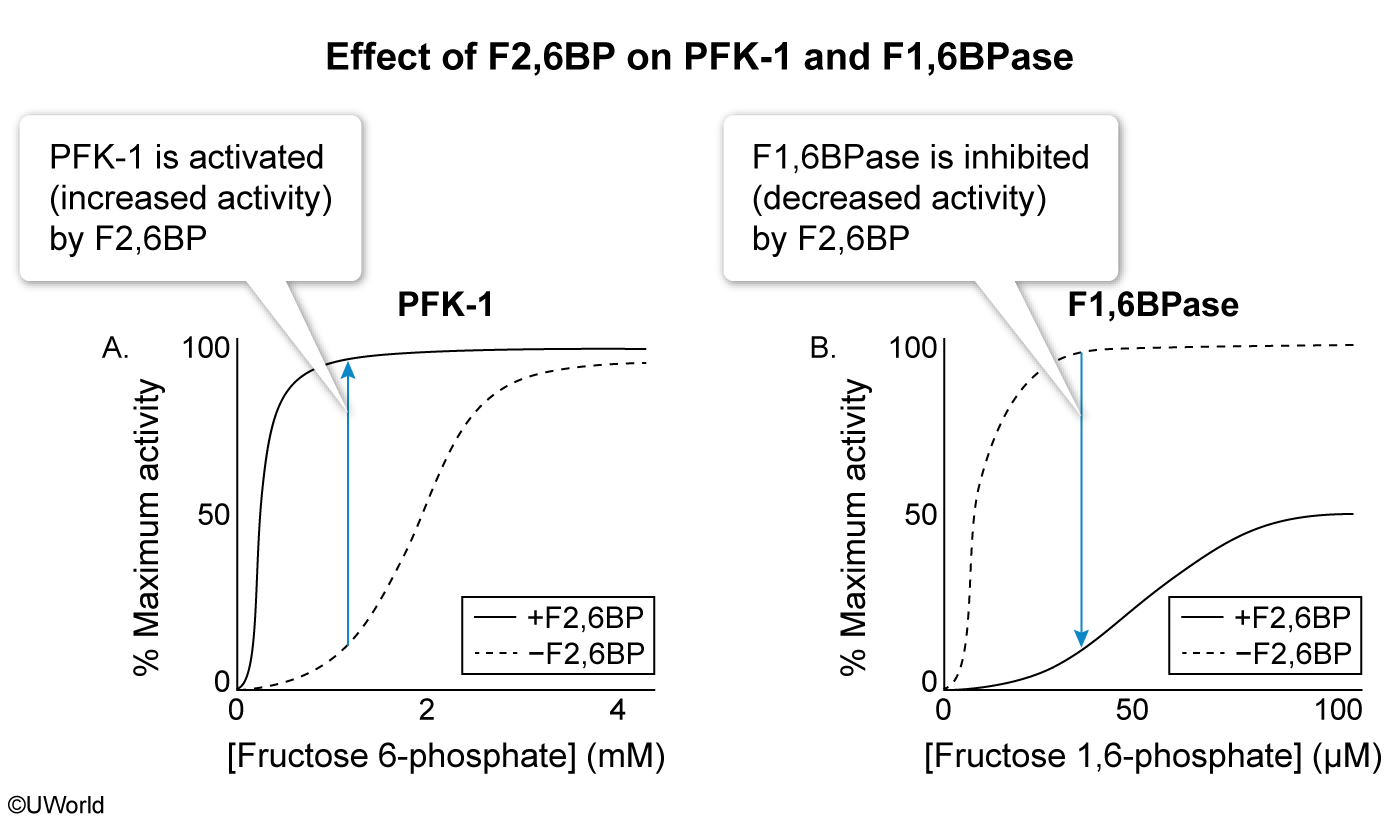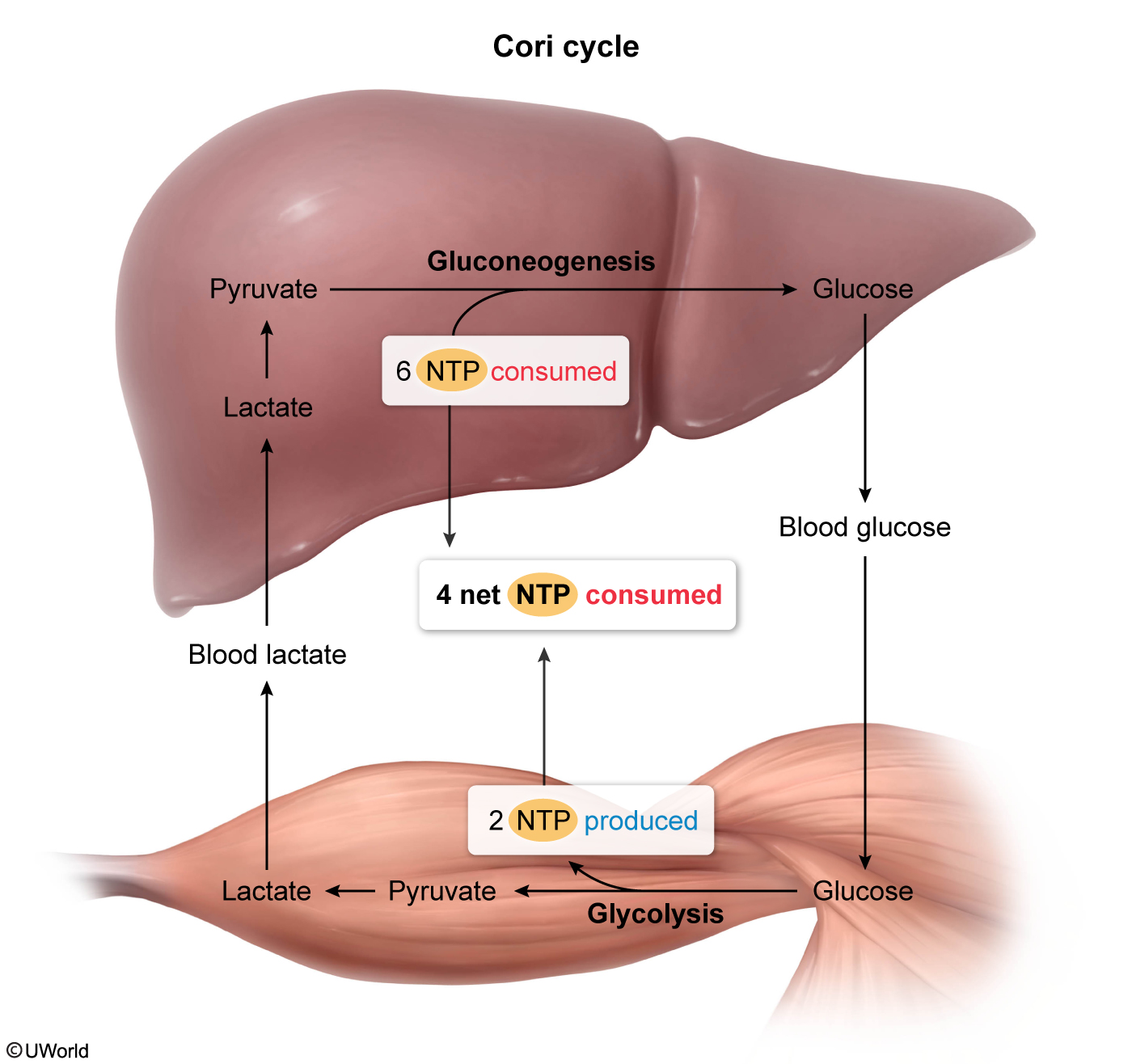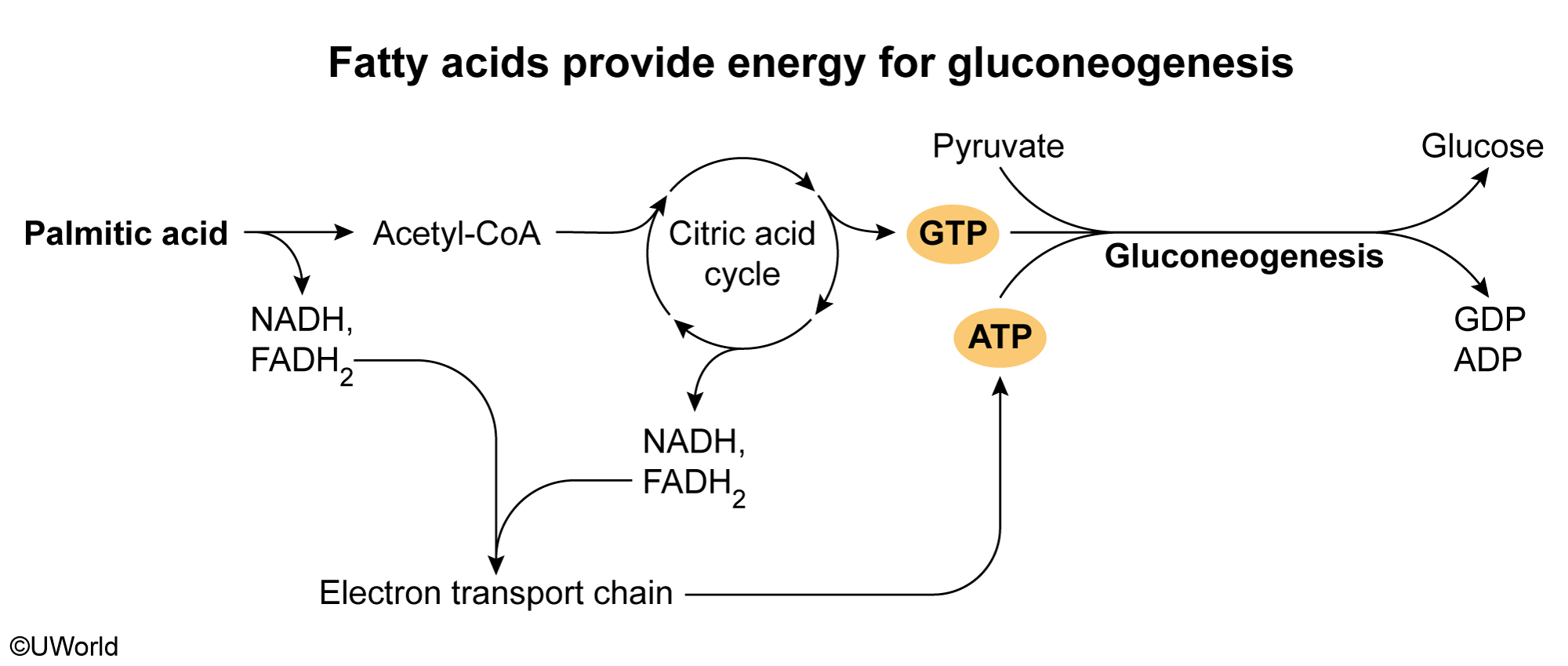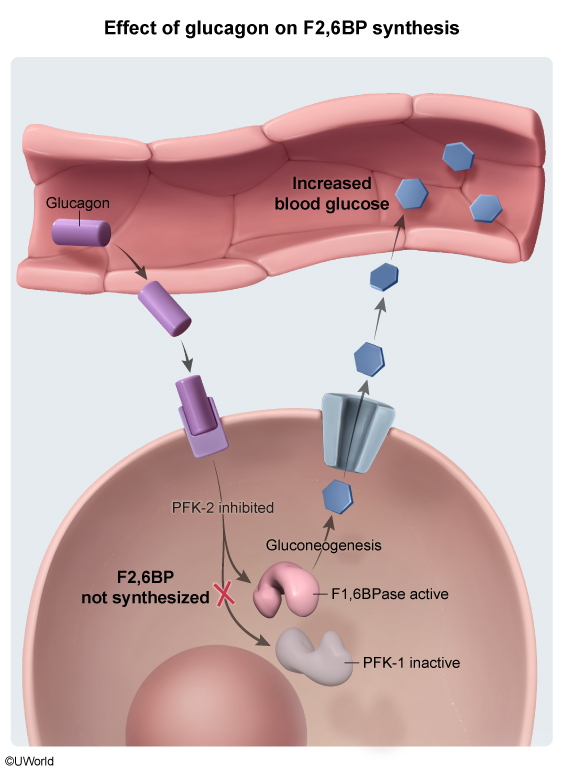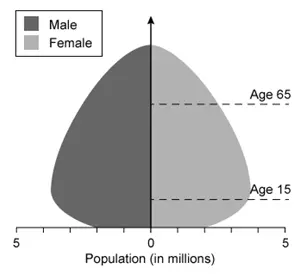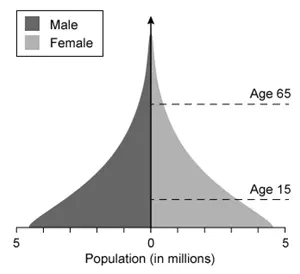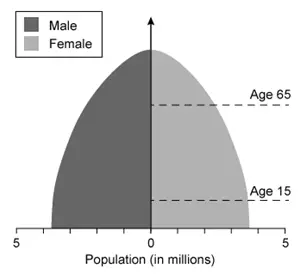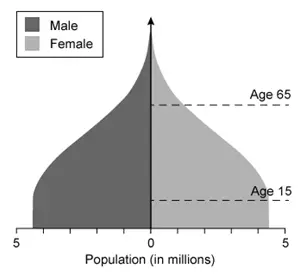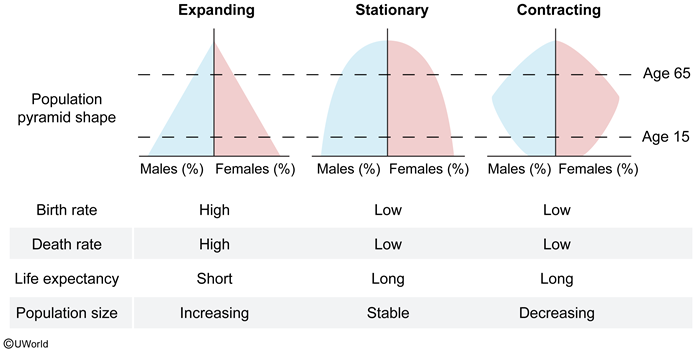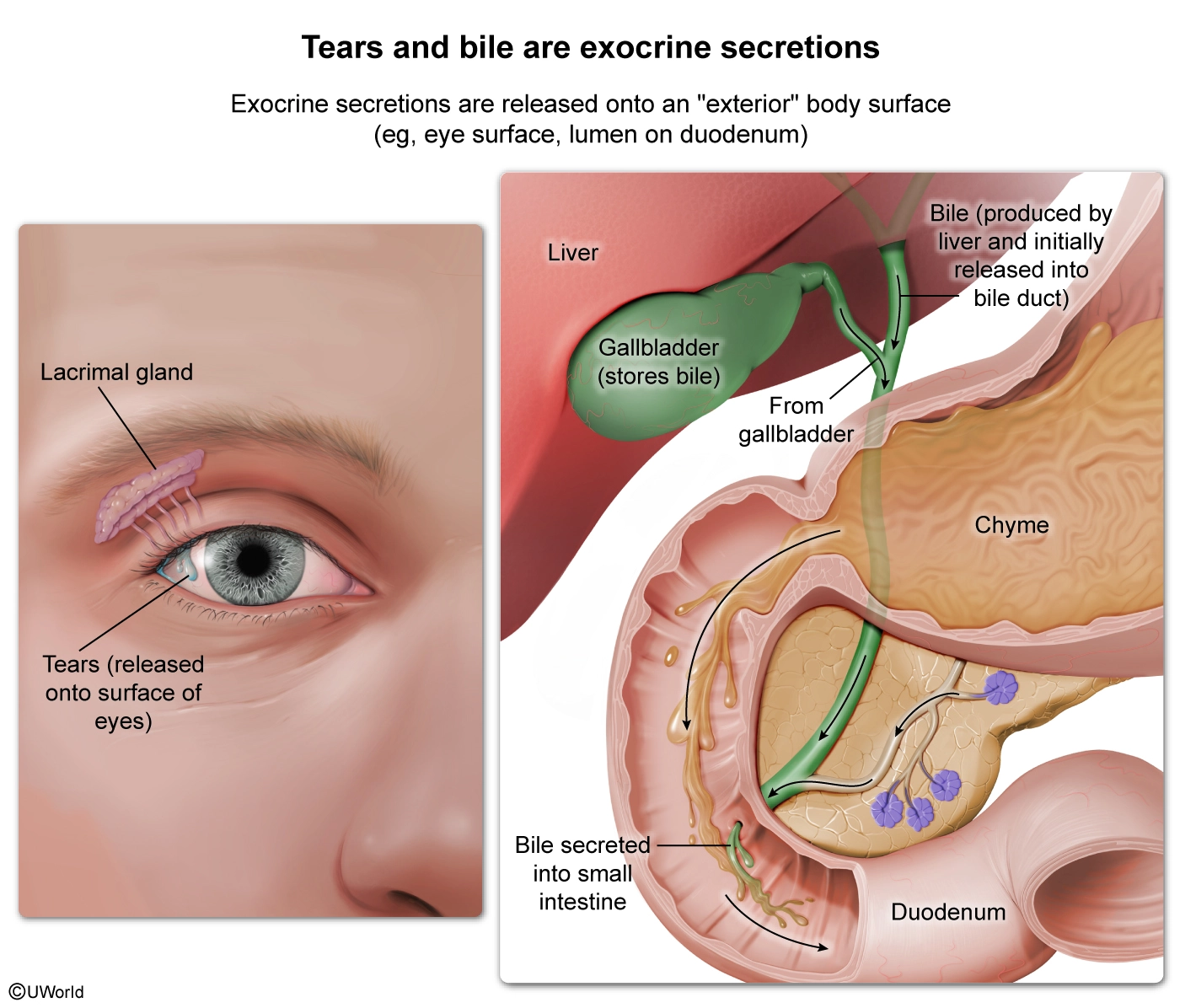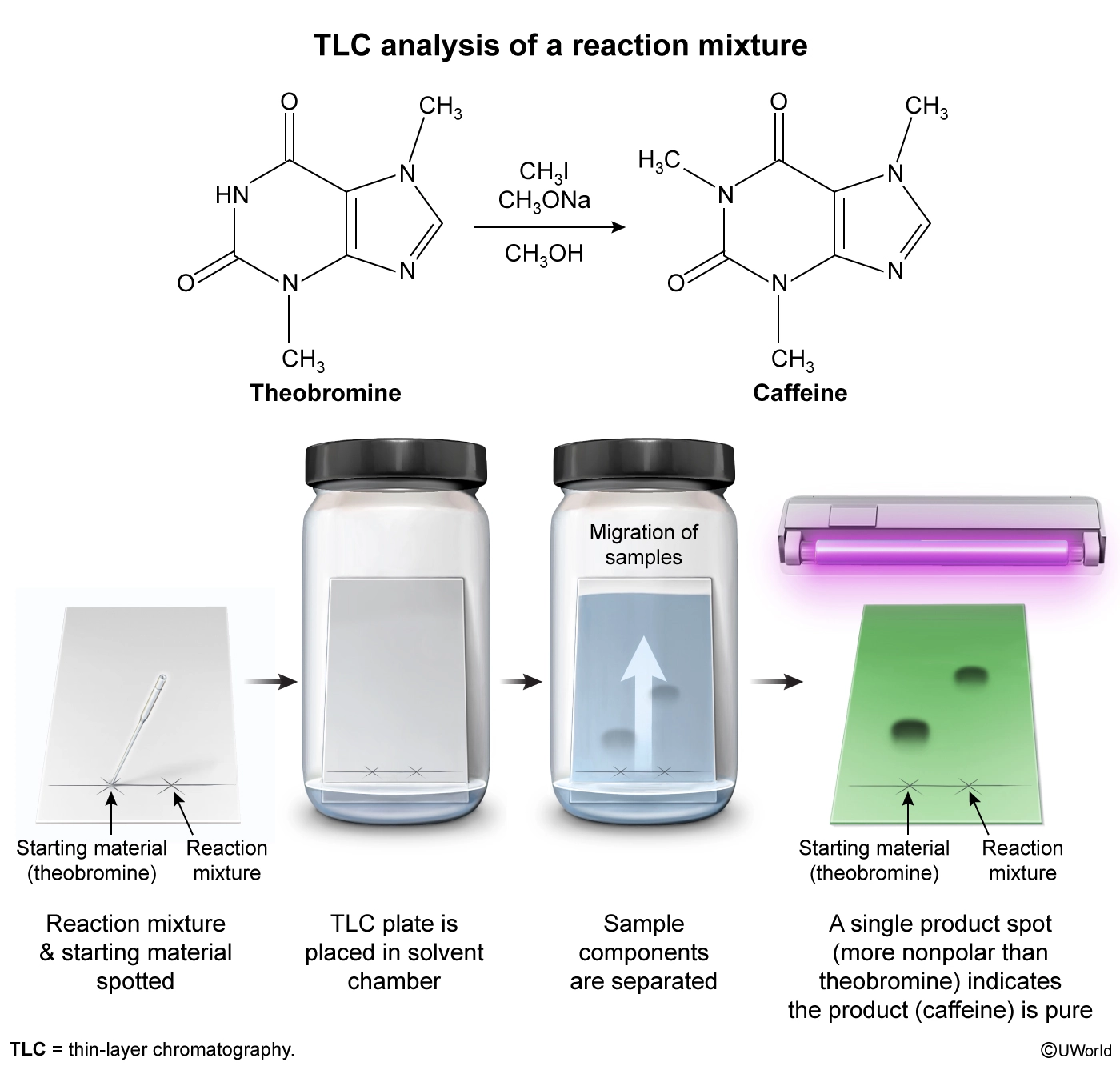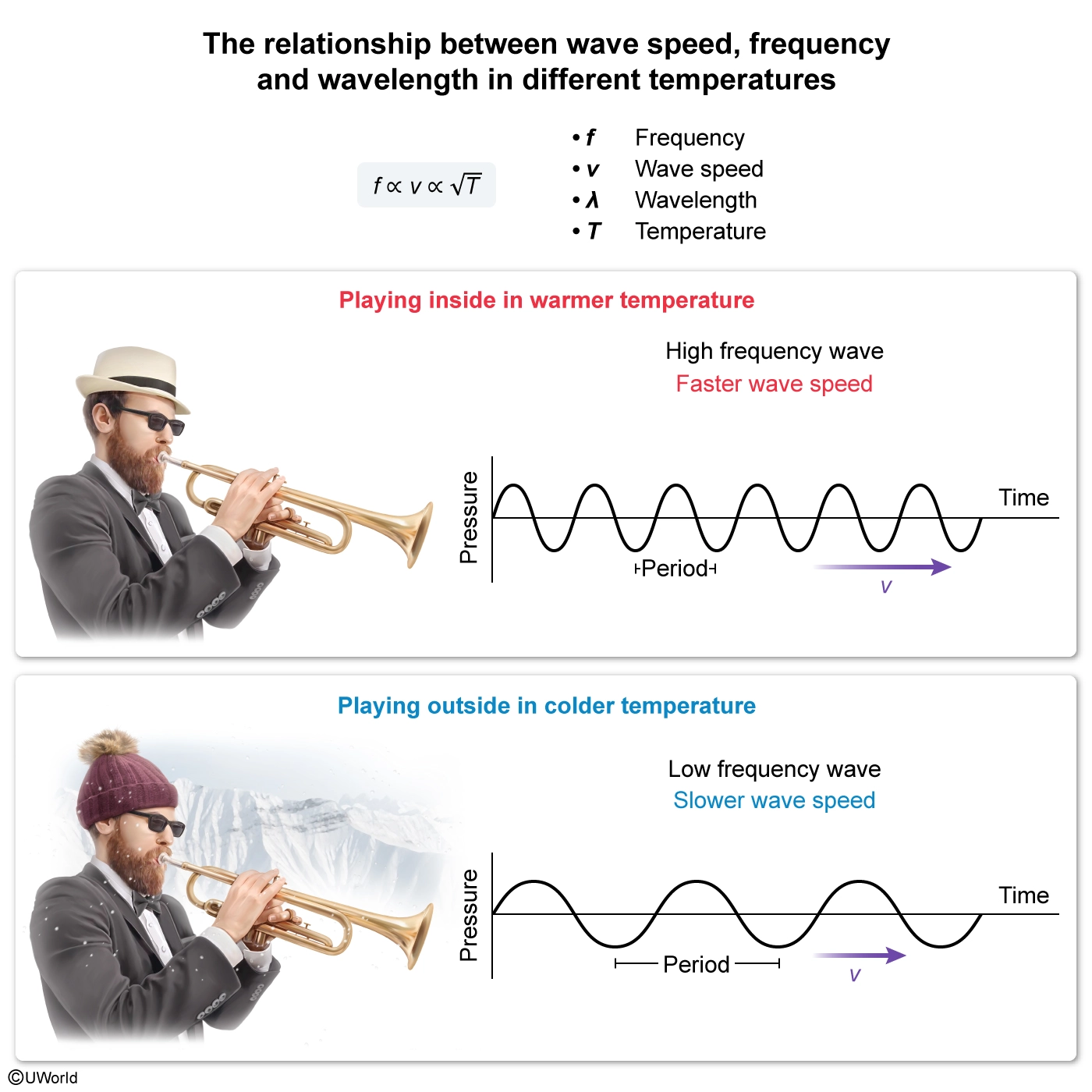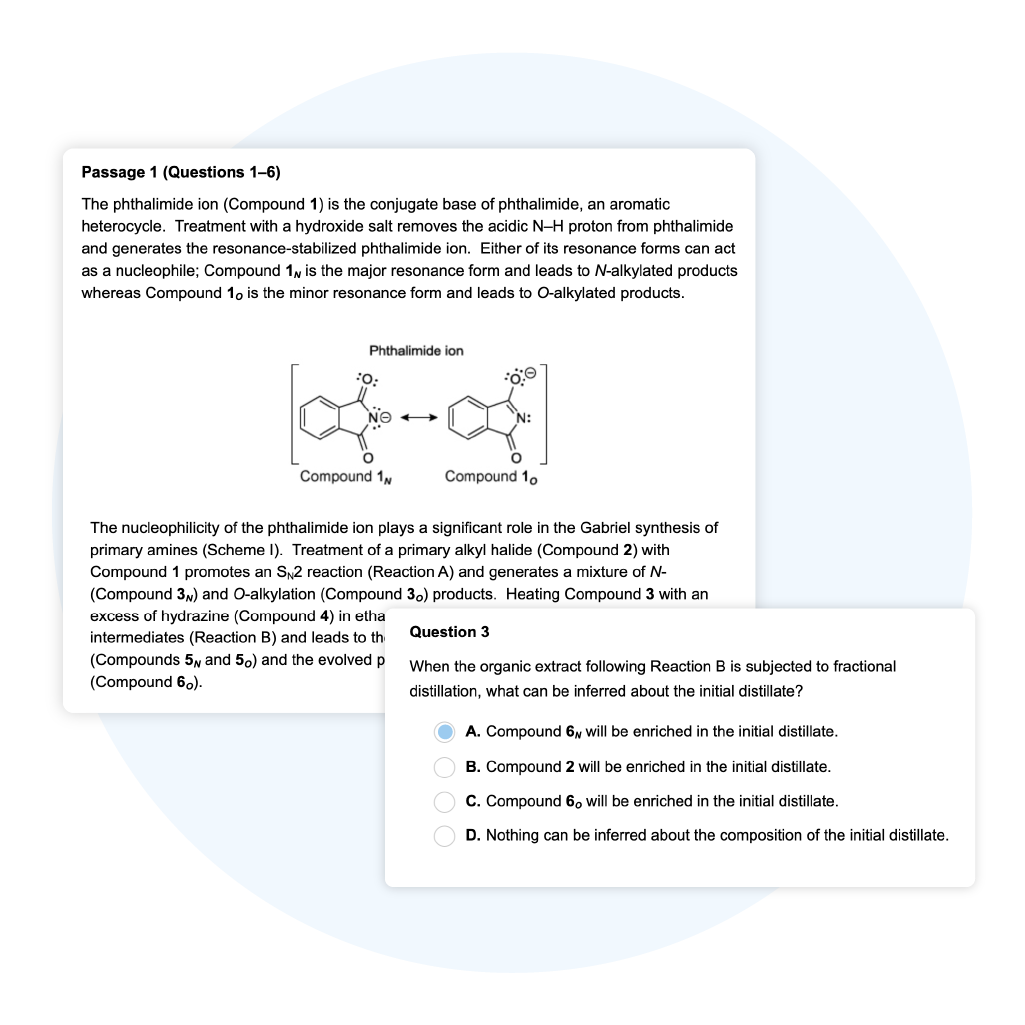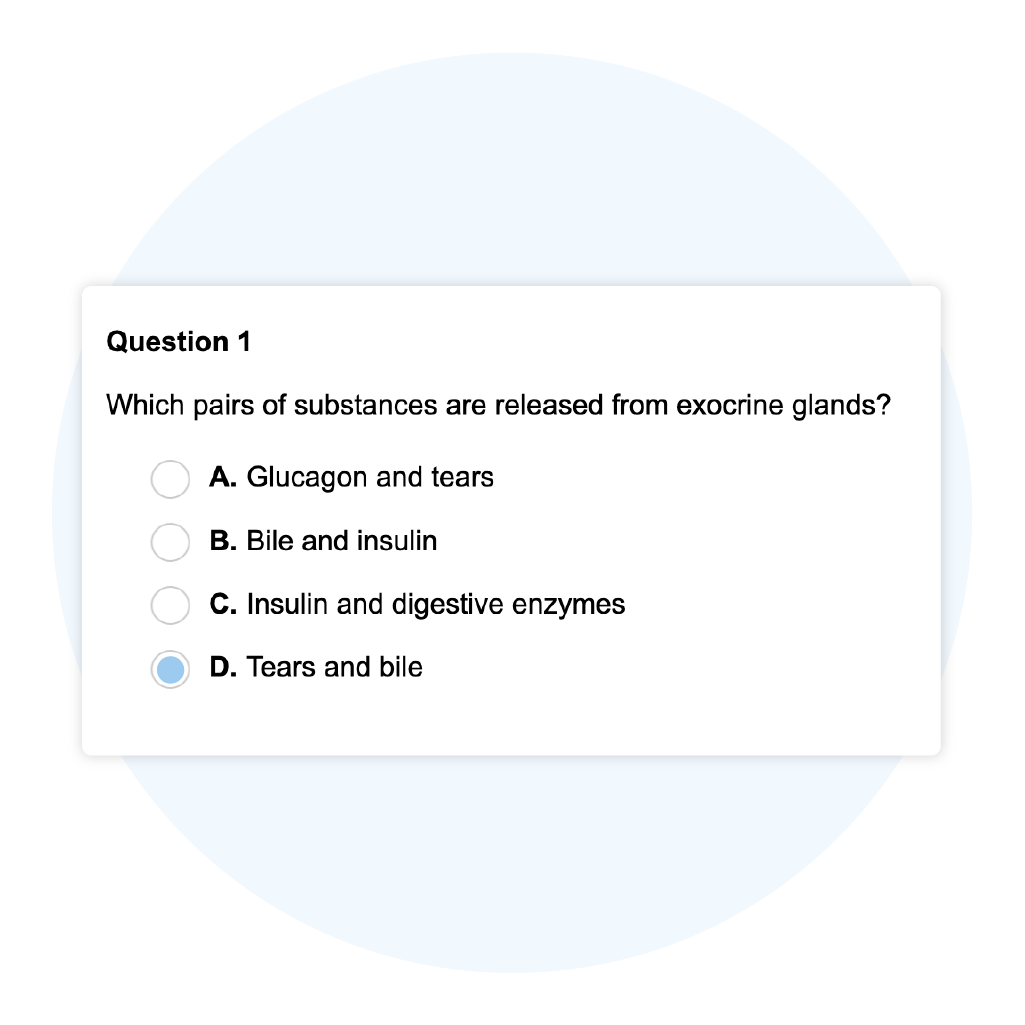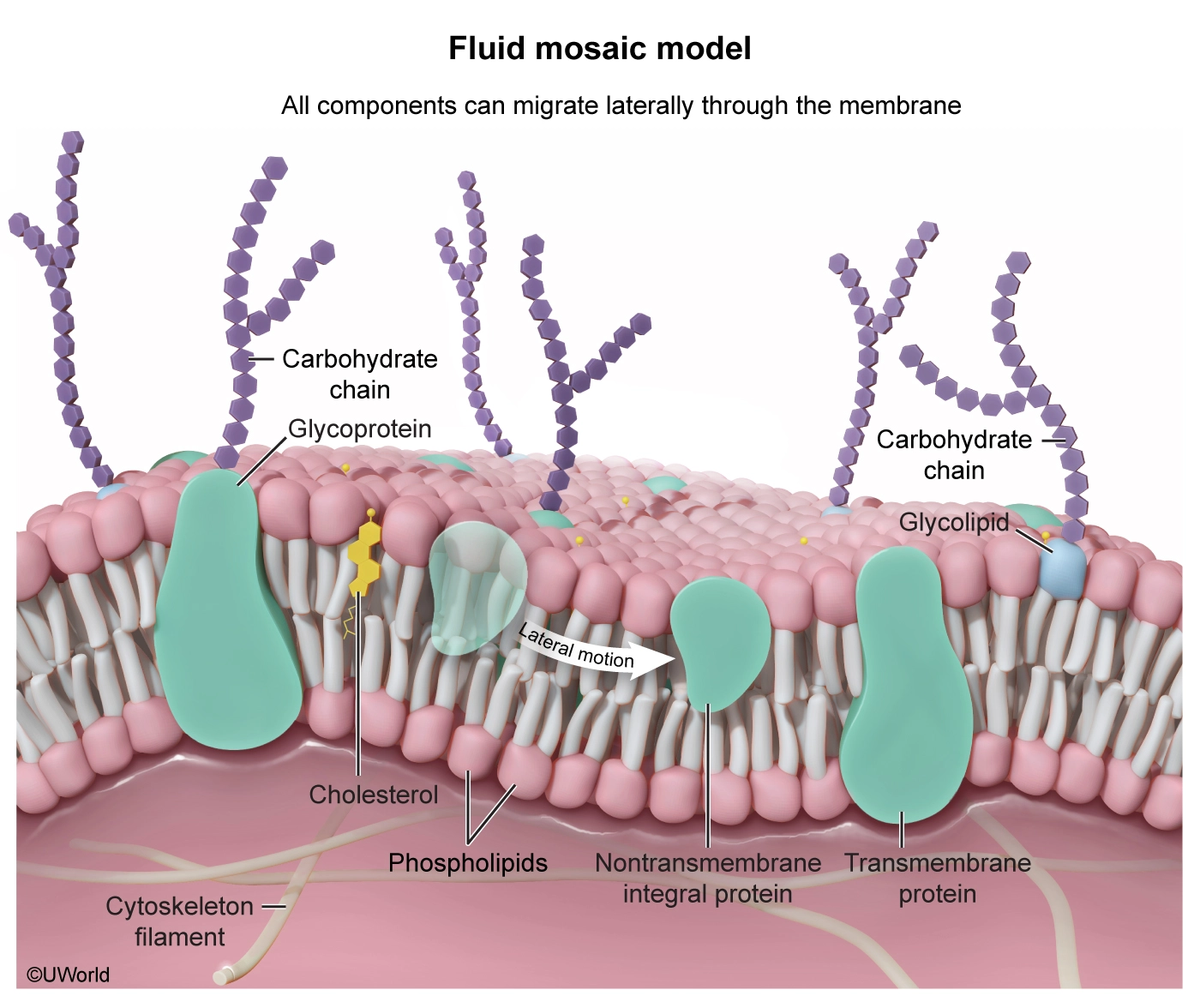Free MCAT® Sample Questions
Take a quick MCAT quiz with representative sample questions from each subject. Once you experience our detailed answer explanations, you’ll understand why our QBank was voted the #1 most helpful MCAT prep resource by students like you!
Glycolysis and gluconeogenesis are tightly regulated, opposing metabolic pathways that help control blood glucose levels. Glycolysis converts glucose to two pyruvate molecules, whereas gluconeogenesis consumes a net total of 6 NTPs (4 ATPs and 2 GTPs) to convert two pyruvate molecules back to glucose. When glycolysis is upregulated, gluconeogenesis is downregulated, and vice versa.
As shown in Figure 1, glycolysis and gluconeogenesis in the liver are largely regulated by the allosteric action of the small molecule fructose-2,6-bisphosphate (F2,6BP) on the enzymes phosphofructokinase-1 (PFK-1) and fructose-1,6-bisphosphatase (F1,6BPase). PFK-1 is a kinase that uses ATP to phosphorylate fructose-6-phosphate (F6P) in an irreversible step of glycolysis, forming fructose-1,6-bisphosphate (F1,6BP) and ADP. During gluconeogenesis, F1,6BPase removes the phosphate group by hydrolysis.
Figure 1 Activities of (A) PFK-1 and (B) F1,6BPase on their respective substrates in the presence (solid lines) and absence (dashed lines) of F2,6BP
A bifunctional enzyme that contains a phosphofructokinase-2 (PFK-2) domain and a fructose-2,6-bisphosphatase (F2,6BPase) domain controls F2,6BP levels in the liver. The PFK-2 domain converts F6P to F2,6BP, and the F2,6BPase domain converts F2,6BP back to F6P. When blood glucose levels are low, the enzyme becomes phosphorylated. This phosphorylation event simultaneously activates the F2,6BPase domain and inactivates the PFK-2 domain. Under high blood glucose conditions, the enzyme becomes dephosphorylated, activating the PFK-2 domain and inactivating the F2,6BPase domain.
All of the following statements about PFK-1 and F1,6BP are correct EXCEPT:
| A. PFK-1 cooperatively converts F6P to F1,6BP. | |
| B. F1,6BPase cooperatively converts F1,6BP to F6P. | |
| C. Both PFK-1 and F1,6BPase have multiple active sites for catalysis. | |
| D. F1,6BPase catalyzes the reverse reaction of PFK-1 to regenerate ATP. |
Metabolic pathways consist of both reversible and irreversible reactions, each of which is catalyzed by an enzyme. For a reversible process, the relevant enzyme catalyzes (ie, decreases the activation energy of) both the forward and the reverse reactions. In irreversible processes, the reverse reaction cannot occur, so converting the product of an irreversible reaction back to its precursor requires a separate process known as a bypass reaction. Bypass reactions are catalyzed by distinct enzymes.
Glycolysis, the conversion of glucose to pyruvate, consists of seven reversible reactions and three irreversible reactions. Gluconeogenesis converts pyruvate back to glucose, and for the reversible steps it uses the same enzymes (eg, 3-phosphoglycerate kinase) as glycolysis to catalyze the reverse reactions.
The question asks for the incorrect statement. To bypass the irreversible steps of glycolysis, gluconeogenesis uses different enzymes than those used in glycolysis to catalyze alternate reactions. According to the passage, PFK-1 transfers a phosphate from ATP to F6P during glycolysis to form ADP and F1,6BP. The reverse reaction would transfer the phosphate back to ADP, regenerating ATP and F6P. However, this reaction is too thermodynamically unfavorable to occur. Instead, gluconeogenesis uses F1,6BPase to hydrolyze the phosphate group from F1,6BP, forming F6P and an inorganic phosphate (Pi), not ATP. Therefore, contrary to the statement in Choice D, F1,6BPase does not catalyze the reverse reaction of PFK-1.
(Choices A, B, and C) Figure 1 shows that both PFK-1 and F1,6BP have sigmoidal (S-shaped) activity curves, indicating that both enzymes are cooperative. Cooperativity occurs when the binding of a substrate to one active site increases the affinity of other active sites for the substrate. In the absence of cooperativity, the shapes of the curves would be hyperbolic. Therefore, by definition, cooperative enzymes must have multiple active sites.
Educational objective:
Metabolic pathways consist of both reversible and irreversible
reactions. Opposing metabolic processes such as glycolysis and gluconeogenesis typically use the same
enzymes for reversible reactions (going in opposite directions) but must use different enzymes to catalyze
distinct reactions for the irreversible steps.
Given the information in Figure 1, are PFK-1 and F1,6BPase activated or inhibited by F2,6BP?
| A. PFK-1 is activated, and F1,6BPase is activated. | |
| B. PFK-1 is activated, and F1,6BPase is inhibited. | |
| C. PFK-1 is inhibited, and F1,6BPase is activated. | |
| D. PFK-1 is inhibited, and F1,6BPase is inhibited. |
Allosteric effectors are small molecules that bind to enzymes at sites other than the active site. Upon binding, allosteric effectors induce conformational changes in enzymes that alter enzyme activity. Allosteric activators increase enzymatic activity, whereas allosteric inhibitors decrease enzymatic activity. Many metabolic pathways are regulated by allosteric effectors, and an effector that activates one metabolic pathway often inhibits the opposing pathway (eg, F2,6BP in glycolysis and gluconeogenesis).
Figure 1 shows the rates of the reactions catalyzed by PFK-1 and F1,6BPase, respectively, with the substrate concentrations for each shown on the corresponding x-axis. Part A shows that in the presence of F2,6BP, the glycolysis enzyme PFK-1 converts its substrate, F6P, into product at a higher rate than in the absence of F2,6BP. Conversely, the gluconeogenesis enzyme F1,6BPase (shown in part B) converts its substrate, F1,6BP, into product at a lower rate in the presence of F2,6BP than in its absence. Therefore, PFK-1 is activated by F2,6BP and F1,6BPase is inhibited.
Educational objective:
Metabolic pathways are commonly regulated by allosteric
effectors. Allosteric effectors bind enzymes at sites other than the active site and induce conformational
changes that alter enzymatic activity. A molecule that allosterically activates one pathway often
allosterically inhibits the opposing pathway.
- 5.3 Graphical Representations of Enzyme Kinetics (see 5.3.01)
If one glucose molecule is converted to pyruvate in the muscle and then the resulting pyruvate molecules are converted back to glucose in the liver, what is the net number of NTPs consumed in this process?
| A. 2 | |
| B. 4 | |
| C. 6 | |
| D. 8 |
Metabolism consists of both catabolic and anabolic pathways. Catabolic pathways degrade complex molecules into simpler molecules to produce high-energy nucleotide triphosphates (ie, NTPs such as ATP or GTP). NTPs provide energy for many biological processes, including muscle contraction. Anabolic pathways use simple molecules (eg, amino acids, sugars) as precursors to synthesize more complex molecules (eg, proteins, polysaccharides). Anabolism requires energy input from NTPs. Most catabolic processes are paired with an opposing anabolic process.
Net NTP production or consumption refers to the difference between the numbers of NTPs produced and consumed in a process. For example, glycolysis (a catabolic process) consumes 2 ATPs and produces 4 ATPs per glucose molecule; therefore, glycolysis has a net production of 2 ATPs (4 − 2 = 2) per glucose. In contrast, the passage states that gluconeogenesis (an anabolic process) consumes a net total of 6 NTPs (4 ATPs and 2 GTPs) to produce one glucose molecule.
Glycolysis in the muscles is connected to gluconeogenesis in the liver by the Cori cycle. In this scenario, the 2 net NTPs that are produced when glucose becomes pyruvate (glycolysis) partially offset the 6 net NTPs that are later consumed when pyruvate is converted back to glucose (gluconeogenesis). Therefore, the net number of NTPs consumed by the process is 6 − 2 = 4 net NTPs consumed in one round of the Cori cycle. Alternatively, this may be described as 8 total NTPs consumed (2 in glycolysis and 6 in gluconeogenesis) and 4 total NTPs produced (in glycolysis only). 8 − 4 = 4 net NTPs consumed.
(Choice A) Glycolysis produces 2 NTPs per glucose molecule, but these molecules, as well as 4 other NTPs, are effectively consumed by gluconeogenesis.
(Choice C) Gluconeogenesis consumes a total of 6 NTPs, but in the given scenario glycolysis also produces 2 NTPs, so the net result is the consumption of 4 NTPs.
(Choice D) The total number of NTPs consumed by one round of the Cori cycle is 8 (2 from glycolysis and 6 from gluconeogenesis), but the question asks for the net number (ie, total consumed − total produced).
Educational objective:
Catabolic processes lead to energy production, typically in
the form of ATP equivalents. In contrast, anabolic processes consume energy. Glycolysis (a catabolic
process) and gluconeogenesis (an anabolic process) are connected by the Cori cycle.
Which metabolic process most likely provides the energy necessary for sustained gluconeogenesis?
| A. Fatty acid oxidation | |
| B. Glycogenolysis | |
| C. Fermentation | |
| D. Pentose phosphate pathway |
Gluconeogenesis is an anabolic process that synthesizes glucose from smaller precursors such as pyruvate. This pathway is used to increase blood glucose levels during times of fasting. According to the passage, gluconeogenesis requires energy input in the form of 6 ATP equivalents (ATP or GTP) for each glucose molecule synthesized. The energy required to produce these ATP equivalents must be provided by a catabolic process. Because the result of gluconeogenesis is the synthesis of carbohydrates, it is unlikely that the necessary energy is provided by carbohydrate degradation. Instead, the needed ATP equivalents are typically produced by fatty acid oxidation.
Fatty acid degradation to acetyl-CoA yields NADH and FADH2, both of which can enter the electron transport chain to produce ATP. In addition, the resulting acetyl-CoA can enter the citric acid cycle to produce more NADH and FADH2, as well as GTP (an ATP equivalent). Therefore, of the choices given, fatty acid oxidation most likely provides the energy needed for sustained gluconeogenesis.
(Choice B)Glycogenolysis produces glucose, so when glycogen is present, gluconeogenesis is not required. Accordingly, gluconeogenesis generally occurs after glycogen stores have been depleted, so glycogenolysis would not be able to provide the needed energy.
(Choice C) In most eukaryotes, fermentation is the conversion of pyruvate to lactate. The resulting lactate can enter gluconeogenesis after being converted back to pyruvate but does not provide the needed energy.
(Choice D) The pentose phosphate pathway converts glucose and glycolysis intermediates to ribose-5-phosphate. This process neither consumes nor produces any ATP, so it does not provide the energy for gluconeogenesis.
Educational objective:
Gluconeogenesis is an anabolic process that requires energy
input from ATP equivalents. The necessary energy is provided by catabolic processes, most commonly by
fatty
acid oxidation.
The information in the passage and the data in Figure 1 support the conclusion that when glycolysis is active, the bifunctional PFK-2/F2,6BPase enzyme is:
| A. phosphorylated and consumes F2,6BP. | |
| B. phosphorylated and produces F2,6BP. | |
| C. dephosphorylated and consumes F2,6BP. | |
| D. dephosphorylated and produces F2,6BP. |
The rate of glycolysis is largely controlled by PFK-1 activity. When PFK-1 is active, glycolysis proceeds quickly, whereas when PFK-1 activity is downregulated, glycolysis is slow. PFK-1 is tightly regulated by several allosteric effectors, including the inhibitors ATP and citrate and the activators ADP, AMP, and F2,6BP.
The data in Figure 1 confirm that PFK-1 is most active when F2,6BP is present, indicating that glycolysis is most active when F2,6BP is abundant. Therefore, conditions that promote glycolysis most likely also promote F2,6BP synthesis. Because the PFK-2 domain produces F2,6BP, it must be active during glycolysis. The passage states that the PFK-2 domain of the bifunctional enzyme is active (and the F2,6BPase domain is inactive) when it is dephosphorylated. Therefore, when glycolysis is active, the PFK-2/F2,6BPase enzyme is most likely dephosphorylated and produces F2,6BP.
(Choice A) When the PFK-2/F2,6BPase enzyme is phosphorylated, the F2,6BPase domain is active and consumes F2,6BP. However, this occurs when gluconeogenesis, not glycolysis, is active.
(Choice B) If PFK-2/F2,6BPase were phosphorylated, it would consume F2,6BP, converting it to F6P, and stimulate gluconeogenesis rather than glycolysis.
(Choice C) When PFK-2/F2,6BPase is dephosphorylated, it produces F2,6BP to stimulate glycolysis, rather than consumes F2,6BP.
Educational objective:
The rate of glycolysis is controlled by PFK-1, which is
stimulated by the allosteric effector F2,6BP. When glycolysis is active, F2,6BP synthesis is also most
likely active.
What effect does glucagon most likely have on F2,6BP synthesis in the liver? Glucagon:
| A. does not alter F2,6BP synthesis. | |
| B. causes an increase in F2,6BP synthesis. | |
| C. causes a decrease in F2,6BP synthesis. | |
| D. causes F2,6BP to be synthesized and degraded in a cycle. |
Blood glucose levels are controlled primarily by the peptide hormones insulin and glucagon. When blood glucose levels are high, the pancreas releases insulin, which induces glucose uptake into cells. Insulin also induces glycolysis and glycogen synthesis, helping remove glucose from the bloodstream. Conversely, when blood glucose levels are low, the pancreas releases glucagon. When glucagon binds to receptors on liver cells, it induces an intracellular response that ultimately upregulates glycogenolysis and gluconeogenesis, leading to the production of glucose that can be released into the blood.
According to Figure 1, F2,6BP stimulates PFK-1 activity to increase glycolysis and inhibits F1,6BPase activity to decrease gluconeogenesis. Glucagon has the opposite effect, decreasing the rate of glycolysis and increasing the rate of gluconeogenesis. Therefore, glucagon most likely causes decreased PFK-2 activity, resulting in decreased F2,6BP synthesis. This downregulates glycolysis and upregulates gluconeogenesis. These effects ultimately help to increase blood glucose levels.
(Choice A) If glucagon had no effect on F2,6BP synthesis, it would be ineffective in regulating glycolysis and gluconeogenesis.
(Choice B) Increased F2,6BP synthesis would lead to increased glycolysis and decreased gluconeogenesis. Glucagon has the opposite effect.
(Choice D) Glucagon causes an intracellular response that increases F2,6BP degradation and decreases synthesis. It does not promote a cycle of synthesis and degradation.
Educational objective:
The hormones insulin and glucagon regulate blood glucose
levels. When blood glucose is high, the pancreas releases insulin, which upregulates glucose uptake,
glycolysis, and glycogen synthesis. When blood glucose is low, the pancreas releases glucagon, which
stimulates gluconeogenesis and glycogenolysis to release glucose from the liver into the bloodstream.
Which of the following population pyramids depicts the population that is most likely to decrease in size in the near future?
Population pyramids, which display the relative number of males and females in each age cohort in a given population, have three general shapes:
-
Expanding pyramids have broad bases (lots of younger people) and narrow tops (few older people) and are characteristic of developing countries with high birth/death rates and an increasing population size.
-
Stationary pyramids have broad bases and broad tops and are characteristic of developed countries with low birth/death rates and a stable population size.
-
Contracting pyramids have narrower bases than middles and are characteristic of developed countries with very low birth rates and a gradually declining population size.
A contracting population pyramid reflects a population with fewer people in the younger age cohorts and more people in the older age cohorts (ie, base is narrower than upper levels of pyramid). In contracting populations, the number of individuals born will not replace the number of older individuals who die, resulting in an overall decrease in population size.
(Choice B) A pyramid with a broad base and narrow top depicts an expanding population that is growing in size.
(Choice C) A pyramid with a broad base and top depicts a stationary population that is relatively stable in size.
(Choice D) A pyramid that is between an expanding and stationary shape depicts a population that was expanding but is in the process of becoming stationary. In this type of population, the growth rate slows, but the overall size of the population does not decrease because more people live to old age.
Educational objective:
A population pyramid is a type of bar graph that depicts the number or percentage of men and women in certain age cohorts in a given population. Expanding pyramids reflect growing
populations with more young than old individuals; stationary pyramids reflect stable populations; and contracting
pyramids reflect gradually declining populations.
Which pairs of substances are released from exocrine glands?
- A. Glucagon and tears
- B. Bile and insulin
- C. Insulin and digestive enzymes
- D. Tears and bile
Certain types of epithelial cells are specialized for the secretion of substances into the extracellular space that surrounds them. Some of these secretory epithelial cells are solitary, being one of many epithelial cell types distributed across the surface of a tissue, whereas others are grouped together in a collection of secreting cells called a gland.
During development, some secretory cells form hollow tubes called ducts into which their secretions flow. For example, mammary glands secrete breast milk through ducts connected to the body’s exterior via the nipple, and sweat glands secrete sweat into ducts that empty onto the skin’s surface via pores. Glands whose secretions are released onto an “exterior” body surface (such as the skin or the inner surface of the lung) are called exocrine glands.
Other secretory epithelial cells develop around blood vessels but lack ducts; these cells release their secretions, called hormones, into the blood. Glands composed of cells such as these are called endocrine glands.
Some organs contain both endocrine and exocrine cells. For example, the pancreas secretes both digestive enzymes (an exocrine secretion) and insulin and glucagon, which are hormones (endocrine secretions).
The question asks for the pair of substances that would be secreted from exocrine glands. Tears are secreted onto the eye’s surface from lacrimal glands near the eyes, and bile is secreted from the liver into the bile duct, from which it is released into the duodenum of the small intestine (recall that the epithelial surfaces of the stomach, intestines, and lungs border cavities that are in communication with the exterior of the body). Therefore, tears and bile are both secreted from exocrine glands.
(Choices A, B, and C) Insulin and glucagon are hormones. Because hormones are secreted into the blood from endocrine glands, these choices are not examples of pairs of substances secreted from exocrine glands.
Educational objective:
Both endocrine and exocrine cells are epithelial cells that produce substances released into the extracellular space. Exocrine secretions are released to the body’s “exterior,” such as the skin or the inner surface of the gut or lungs. Endocrine secretions are released into the blood.
2 Bi(s) + 5 F2(g) → 2 BiF5(s)
Metallic, elemental bismuth reacts with yellow fluorine gas to form a white solid of bismuth(V) fluoride according to the balanced equation above. How many grams of fluorine gas are needed to fully convert 836 g of bismuth in this reaction?
The molar mass of a compound is the amount of mass contained in 1 mole of the compound (ie, the grams per mole) and can be used to convert the mass of a compound to the equivalent number of moles. As such, the number of moles of Bi(s) in an 836 g sample can be found by dividing the mass of Bi(s) by its molar mass from the periodic table:
The number of moles of a chemical species is related to the number of moles of another chemical species in a reaction by the mole ratios of the stoichiometric coefficients from a balanced reaction equation.The given balanced reaction equation shows that 5 mol of F2(g) are consumed for every 2 mol of Bi(s) that reacts. Applying this mole ratio, the number of moles of F2(g) needed to fully convert the Bi(s) sample in the reaction is:
The mass of this number of moles of F2(g) can be found by multiplying the moles of F2(g) by its molar mass calculated from the periodic table (ie, molar mass F2(g) = 2 × 19.0 g/mol = 38.0 g/mol).
(Choice A) A mass of 60.8 g results if the mole ratio 5 mol F2(g)/2 mol Bi(s)is mistakenly inverted as 2 mol Bi(s)/5 mol F2(g) during the second step of the calculation.
(Choice B) A mass of 152 g is obtained by incorrectly assuming a 1:1 mole ratio for F2(g):Bi(s) during the second step of the calculation.
(Choice C) A mass of 190 g is calculated if the molar mass of F (19.0 g/mol) is used instead of the molar mass of F2(g) (38.0 g/mol) in the last step of the calculation.
Educational objective:
The molar mass (the amount of mass in 1 mole of a compound)
permits conversions between a given amount of mass and the number of moles that it contains.
Stoichiometric mole ratios from a balanced reaction equation relate the number of moles of a chemical
species to the moles of another chemical species in a reaction.
Consider the reaction below.
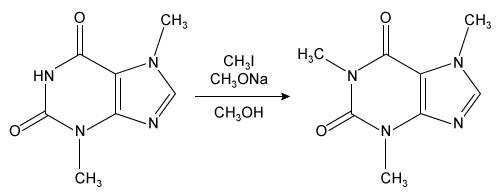
Which of the following observations would most likely indicate that the product from this reaction is pure?
- A. One absorbance peak from size-exclusion chromatography
- B. Two peaks in a high-performance liquid chromatogram
- C. Two unique −CH3 signals in the 1H NMR spectrum
- D. A single spot in the reaction mixture lane on a thin-layer chromatography plate
Several techniques can be used to evaluate the purity of a compound, including thin-layer chromatography (TLC), which separates compounds in a mixture based on polarity. In TLC, the tested sample is dissolved in an organic solvent and a small amount is spotted onto the stationary phase (commonly a polar silica [SiO2]) coated on a TLC plate. After spotting, the TLC plate is placed in a solvent chamber, and the mobile phase (organic solvent) travels up the plate and carries the spotted compounds along at different rates, which separates the mixture components. Nonpolar compounds have less affinity for a polar stationary phase and will travel further up the plate than polar compounds.
The conversion of theobromine to caffeine results in N-methylation (conversion of N–H to N–CH3), resulting in a large change in polarity. The N–H in theobromine can hydrogen bond to the polar stationary phase on the TLC plate, whereas the N–CH3 in caffeine cannot hydrogen bond. Because theobromine can hydrogen bond, it is more polar and has a smaller Rf value than caffeine, and it produces distinguishably different spots on a TLC plate. Therefore, TLC can be used to assess product purity by comparing a standard of pure theobromine to the isolated product. If a single spot with a larger Rf than that of theobromine is visible on the reaction mixture lane on the TLC plate, this indicates that the reaction proceeded to completion, no more reactant remained, and the isolated product is pure.
(Choice A) Size-exclusion chromatography separates compounds by size; therefore, compounds that are similar in size elute together. Theobromine and caffeine are very similar in size, differing only by a methylene group. Size-exclusion chromatography is unlikely to provide enough resolution to distinguish the two molecules; instead, they are likely to elute together and appear in one peak.
(Choice B) Although high-performance liquid chromatography (HPLC) can be used to determine product purity, a pure reaction product would show only one peak (not two) on the HPLC chromatogram.
(Choice C) There are three unique methyl (−CH3) groups in the reaction product caffeine; therefore, three unique −CH3 signals would be seen in its 1H NMR spectrum. Two unique −CH3 signals would indicate the product had not formed because the reactant (ie, theobromine) has only two unique −CH3 groups.
Educational objective:
Thin-layer chromatography (TLC) is a technique used to evaluate a
compound’s purity. The components of a mixture are separated based on polarity, and a single spot on a TLC plate is
indicative of a compound’s purity.
A musician plays the trumpet in a marching band. The musician tunes the trumpet inside a room and then goes outside to play. When outside, the trumpet sounds flat (plays a lower frequency). Which of the following could account for the decrease in the frequency?
- A. The air outside is warmer than inside, which increased the speed of the sound waves.
- B. More energy is dissipated outside, which caused the sound waves to lose energy.
- C. The musician shortened the length of the trumpet, which decreased the wavelength of the sound waves.
- D. The air outside is cooler than inside, which decreased the speed of the sound waves.
A wave is a motion created by a disturbance in a medium. A wave moves through the medium with a speed v that is related to the wavelength λ and frequency f:
Rearranging, the frequency of a sound wave is directly proportional to v and inversely proportional to λ:
The speed of waves is determined by the physical properties of the medium through which they travel. For example, the speed of sound waves depends on the temperature of the medium: sound travels faster in warmer air and slower in cooler air. In particular, the speed of sound in air follows the following formula (in kelvin, K):
Consequently, when the wavelength is constant, an increase (or decrease) in wave speed results in a corresponding increase (or decrease) in the wave’s frequency.
In this question, the air in a trumpet’s tube exhibits resonances at certain wavelengths that are determined by the length of the tube. If the tube length is fixed, any decrease in resonant frequency is caused by a decrease in v. Therefore, the decrease in frequency (flat sound) can be accounted for by the air outside being cooler than the air inside, which decreases the speed of the sound waves.
(Choice A) Sound waves travel faster in warmer air. Hence, the speed of sound waves increases, causing the frequency to increase, not decrease.
(Choice B) The energy of a wave is related to the wave’s intensity and loudness. Dissipation of energy does not affect the frequency of a wave.
(Choice C) The wavelength of a sound wave produced by a brass instrument depends on the length of the tube. A shorter trumpet results in a shorter wavelength and a higher frequency.
Educational objective:
The frequency of sound is directly related to wave speed and inversely
related to wavelength. Sound waves travel faster in warmer air and slower in cooler air.
Locomotives were invented in England, with the first major railroad connecting Liverpool and Manchester in 1830. However, it was in America that railroads would be put to the greatest use in the nineteenth century. On May 10, 1869, the Union Pacific and Central Pacific lines met at Promontory Point, Utah, joining from opposite directions to complete a years-long project—the Transcontinental Railroad. This momentous event connected the eastern half of the United States with its western frontier and facilitated the construction of additional lines in between. As a result, journeys that had previously taken several months by horse and carriage now required less than a week’s travel. By 1887 there were nearly 164,000 miles of railroad tracks in America, and by 1916 that number had swelled to over 254,000.
While the United States still has the largest railroad network in the world, it operates largely in the background of American life, and citizens no longer view trains with the sense of importance those machines once commanded. Nevertheless, the economic and industrial advantages those citizens enjoy today would not have been possible without America’s history of trains; as Tom Zoellner reminds us, “Under the skin of modernity lies a skeleton of railroad tracks.” Although airplanes and automobiles have now assumed greater prominence, the time has arrived for the resurgence of railroads. A revitalized and advanced railway system would confer numerous essential benefits on both the United States and the globe.
The chief obstacles to garnering support for such a project are the current dominance of the automobile and the languishing technology of existing railroads. In a sense these two obstacles are one, as American dependence on personal automobiles is partially due to the paucity of rapid public transportation. The railroads of Europe and Japan, by comparison, have vastly outpaced their American counterparts. Japan has operated high-speed rail lines continuously since 1964, and in 2007, a French train set a record of 357 miles per hour. While that speed was achieved under tightly controlled conditions, it still speaks to the great disparity in railroad development between the United States and other countries since the mid-twentieth century. British trains travel at speeds much higher than those in America, where both the trains themselves and the infrastructure to support them have simply been allowed to fall behind. In much of Europe it is common for trains to travel at close to 200 miles per hour.
To invest in a modern network of railroads would improve the United States in much the same way that the first railroads did in the nineteenth and early twentieth centuries. A high-speed passenger rail system would dramatically transform American life as travel between cities and states became quicker and more convenient, encouraging commerce, business, and tourism. Such a system would also make important strides in environmental preservation. According to a 2007 British study, “CO2 emissions from aircraft operations are…at least five times greater” than those from high-speed trains. For similar reasons, Osaka, Japan, was ranked as “the best…green transportation city in Asia” by the 2011 Green City Index. As Lee-in Chen Chiu notes in The Kyoto Economic Review, Osakans travel by railway more than twice as much as they travel by car.
It is true that developing a countrywide high-speed rail system would come with significant costs. However, that was also true of the original Transcontinental Railroad, as indeed it is with virtually any great project undertaken for the public good. We should thus move ahead with confidence that the rewards will outweigh the expenditure as citizens increasingly choose to travel by train. Both for society’s gain and the crucial well-being of the planet, our path forward should proceed upon rails.
Which of the following passage assertions is the most essential for readers to accept in order for them to find the author’s argument reasonable?
| A. The airline and car industries have undue influence over American travel. | |
| B. A high-speed railroad network would encourage economic activity. | |
| C. The superiority of foreign railroads disadvantages America in international trade. | |
| D. The public would readily adopt high-speed rail travel if it were available. |
Although airplanes and automobiles have now assumed greater prominence, the time has arrived for the resurgence of railroads. A revitalized and advanced railway system would confer numerous essential benefits on both the United States and the globe. (Paragraph 2)
In a sense these two obstacles are one, as American dependence on personal automobiles is partially due to the paucity of rapid public transportation. (Paragraph 3)
A high-speed passenger rail system would dramatically transform American life as travel between cities and states became quicker and more convenient, encouraging commerce, business, and tourism. Such a system would also make important strides in environmental preservation. According to a 2007 British study, “CO2 emissions from aircraft operations are…at least five times greater” than those from high-speed trains. (Paragraph 4)
We should thus move ahead with confidence that the rewards will outweigh the expenditure as citizens increasingly choose to travel by train. Both for society’s gain and the crucial well-being of the planet, our path forward should proceed upon rails. (Paragraph 5)
The author’s argument is that America should build a high-speed rail system because doing so would grant “numerous essential benefits on both the United States and the globe” (Paragraph 2). These benefits include “encouraging commerce, business, and tourism” as well as making “important strides in environmental preservation” (Paragraph 4). However, those benefits would occur only if the public is willing to use high-speed rail as a frequent mode of transportation.
The author suggests that this willingness exists. For instance, Paragraph 3 states that “American dependence on personal automobiles is partially due to the paucity (lack) of rapid public transportation,” implying that Americans would use such transportation if they had access to it. Likewise, Paragraph 5 makes this point more explicitly by asserting that “the rewards [of high-speed rail] will outweigh the expenditure as citizens increasingly choose to travel by train.”
Nevertheless, if American citizens continued to depend mostly on airplanes and cars even with high-speed trains available, then such trains would not actually provide the benefits that the author envisions. Consequently, for readers to find the author’s argument reasonable, it is most essential for them to accept the assertion that the public would readily adopt high-speed rail travel if it were available.
(Choice A) The airline and car industries have undue influence over American travel. Paragraph 2 states that “airplanes and automobiles have now assumed greater prominence” compared to trains in America, and Paragraph 3 cites “the current dominance of the automobile” as an obstacle to support for high-speed trains. Accordingly, the author would likely agree that the airline and car industries have undue influence over American travel. However, his or her argument depends more crucially on the idea that those industries’ influence is caused by “the paucity of rapid public transportation” (Paragraph 3), and thus that the public would readily adopt high-speed rail travel if it were available.
(Choice B) A high-speed railroad network would encourage economic activity. According to Paragraph 4, “A high-speed passenger rail system would dramatically transform American life…encouraging commerce, business, and tourism.” However, these economic benefits (as well as any environmental ones) could only be realized if citizens choose to embrace this mode of transportation. Therefore, the assertion that a high-speed railroad network would encourage economic activity is less essential to the author’s argument than the idea that the public would adopt high-speed rail travel once it is available.
(Choice C) The superiority of foreign railroads disadvantages America in international trade. Paragraph 3 states that “[t]he railroads of Europe and Japan…have vastly outpaced their American counterparts.” Although this statement indicates that foreign railroads are superior to those in America, the author’s argument is not based on the idea that building high-speed railroads would improve America’s international trade. Rather, the author claims that “travel between [American] cities and states would become quicker and more convenient” and that such railroads would “make important strides in environmental preservation” (Paragraph 4).
Which of the following is most like the relationship between American railroads and British railroads as they are described in the passage?
| A. An apprentice artist surpasses a master’s early works but does not live up to the master’s later works. | |
| B. A financial investor earns large sums of money in the short term but loses a larger amount over time. | |
| C. A rookie athlete sets a team record but in later seasons his record is broken by a newer player. | |
| D. An investigative journalist races to break a story but is beaten to the punch by a rival network. |
Locomotives were invented in England, with the first major railroad connecting Liverpool and Manchester in 1830. However, it was in America that railroads would be put to the greatest use in the nineteenth century. (Paragraph 1)
While that speed was achieved under tightly controlled conditions, it still speaks to the great disparity in railroad development between the United States and other countries since the mid-twentieth century. British trains travel at speeds much higher than those in America, where both the trains themselves and the infrastructure to support them have simply been allowed to fall behind. (Paragraph 3)
According to the passage, the first American trains overshadowed their British counterparts, but in modern times British trains are superior. For instance, Paragraph 1 conveys that although “[l]ocomotives were invented in England…it was in America that railroads would be put to the greatest use in the nineteenth century.” Paragraph 3 then explains that there has been a “great disparity in railroad development between the United States and other countries since the mid-twentieth century.” In particular, “British trains travel at speeds much higher than those in America, where both the trains themselves and the infrastructure to support them have simply been allowed to fall behind.”
Therefore, this relationship is most analogous to a situation in which an apprentice artist surpasses a master’s early works but does not live up to the master’s later works. Like the British railroads, the original artist (the master) was first surpassed, but his later works re-established his superior position.
By contrast, none of the following situations is most analogous to the relationship between American railroads and British railroads, because they do not include a re-established superiority:
-
A financial investor earns large sums of money in the short term but loses a larger amount over time (Choice B). There is no suggestion in this analogy that such an investor later recoups her losses. Moreover, her situation is not described in relation to another entity that surpasses her.
-
A rookie athlete sets a team record but in later seasons his record is broken by a newer player (Choice C). In the scenario described, the rookie’s record is later broken by a newer player, not by the previous record holder. Accordingly, while the newer player sets a superior record, he does not re-establish his superiority.
-
An investigative journalist races to break a story but is beaten to the punch by a rival network (Choice D). There is no suggestion in this analogy that the journalist later beats the rival network to the punch on other stories.
For which of the following passage claims does the author provide supporting evidence?
| A. Developing a countrywide high-speed rail system would come with significant costs. | |
| B. A high-speed passenger rail system would dramatically transform American life. | |
| C. The United States still has the largest railroad network in the world. | |
| D. Increasing the use of high-speed railroads would be beneficial for the environment. |
A high-speed passenger rail system would dramatically transform American life as travel between cities and states became quicker and more convenient, encouraging commerce, business, and tourism. Such a system would also make important strides in environmental preservation. According to a 2007 British study, “CO2 emissions from aircraft operations are…at least five times greater” than those from high-speed trains. For similar reasons, Osaka, Japan, was ranked as “the best…green transportation city in Asia” by the 2011 Green City Index. As Lee-in Chen Chiu notes in The Kyoto Economic Review, Osakans travel by railway more than twice as much as they travel by car. (Paragraph 4)
Paragraph 4 states that a high-speed rail system would “make important strides in environmental preservation.” The author then supports this claim with data comparing the environmental effects of rail travel to those of travel by airplane or automobile: “According to a 2007 British study, ‘CO2 emissions from aircraft operations are…at least five times greater’ than those from high-speed trains.” Similarly, “Osaka, Japan, was ranked as ‘the best…green transportation city in Asia’ by the 2011 Green City Index,” and “Osakans travel by railway more than twice as much as they travel by car.”
Therefore, the author provides supporting evidence for the claim that increasing the use of high-speed railroads would be beneficial for the environment.
By contrast, the author provides no supporting evidence for the following claims:
-
Developing a countrywide high-speed rail system would come with significant costs (Choice A). According to Paragraph 5, “developing a countrywide high-speed rail system would come with significant costs.” However, the author makes this assertion without providing any specific information regarding such costs.
-
A high-speed passenger rail system would dramatically transform American life (Choice B). Paragraph 4 states that “[a] high-speed passenger rail system would dramatically transform American life as travel between cities and states became quicker and more convenient, encouraging commerce, business, and tourism.” However, the author provides no data to support the idea that such a transformation would occur.
-
The United States still has the largest railroad network in the world (Choice C). Paragraph 1 states that “[b]y 1887 there were nearly 164,000 miles of railroad tracks in America, and by 1916 that number had swelled to over 254,000.” Paragraph 2 then asserts that “the United States still has the largest railroad network in the world.” However, this assertion is not supported by evidence because the author does not provide the current total mileage of railroad tracks in America nor compare that number to the mileage of other countries’ railroad networks.
How would the author’s argument be impacted if studies suggest there is an increasing trend of people using ride-sharing services for transportation?
| A. It would refute the author’s suggestion that trains would help fill a transportational need. | |
| B. It would weaken the author’s comparison between the Transcontinental Railroad and high-speed rail. | |
| C. It would support the author’s assumption that the public could be willing to depend less on vehicle ownership. | |
| D. It would reinforce the author’s claim that automobiles have made public transportation less important |
The chief obstacles to garnering support for such a project are the current dominance of the automobile and the languishing technology of existing railroads. In a sense these two obstacles are one, as American dependence on personal automobiles is partially due to the paucity of rapid public transportation. The railroads of Europe and Japan, by comparison, have vastly outpaced their American counterparts. (Paragraph 3)
We should thus move ahead with confidence that the rewards will outweigh the expenditure as citizens increasingly choose to travel by train. (Paragraph 5)
Part of the author’s argument is that Americans would use more public transportation if it were feasible, but they are often forced to depend on vehicle ownership out of necessity. For example, Paragraph 3 connects the “current dominance of the automobile” in American life to the “languishing (neglected or weakened) technology of existing railroads,” and asserts that “American dependence on personal automobiles is partially due to the paucity (lack) of rapid public transportation.” Similarly, in Paragraph 5 the author asserts that if a high-speed rail network were built, “citizens [would] increasingly choose to travel by train,” which would reduce the need for them to own cars.
Thus, if there is an increasing trend of people using ride-sharing services for transportation, this trend would indicate that people are moving away from depending on their own vehicles for travel. Accordingly, such a trend would support the author’s assumption that the public could be willing to depend less on vehicle ownership.
(Choice A) It would refute the author’s suggestion that trains would help fill a transportational need. The author advocates high-speed rail as a way to address “the paucity of rapid public transportation” (Paragraph 3) in America. In addition, he or she implies that such a rail system would help take the place of air travel, noting that “‘CO2 emissions from aircraft operations are…at least five times greater’ than those from high-speed trains” (Paragraph 4). Thus, a trend toward increased use of ride-sharing services suggests a need for additional transportation options which trains might also help to fill. Moreover, ride-sharing is unlikely to replace air travel as the author suggests high-speed rail might do. Therefore, an increasing trend of people using ride-sharing services for transportation would not refute the idea that trains would help fill a transportational need.
(Choice B) It would weaken the author’s comparison between the Transcontinental Railroad and high-speed rail. According to Paragraph 5, “developing a countrywide high-speed rail system would come with significant costs. However, that was also true of the original Transcontinental Railroad, as indeed it is with virtually any great project undertaken for the public good.” Therefore, the author compares the Transcontinental Railroad and modern high-speed rail as ambitious but costly projects designed for society’s benefit. The basis for this comparison is not affected by an increase in the number of people using ride-sharing services.
(Choice D) It would reinforce the author’s claim that automobiles have made public transportation less important. Paragraph 3 states that “American dependence on personal automobiles is partially due to the paucity of rapid public transportation.” Accordingly, the author argues that there is a lack of effective public transportation in America, to which the predominance of automobiles is a response. However, he or she does not claim that automobiles have made public transportation less important.
In the context of the passage, which of the following best explains Zoellner’s claim that “[u]nder the skin of modernity lies a skeleton of railroad tracks”?
| A. American trains now represent an obsolete technology. | |
| B. American trains have been overshadowed by other forms of transportation. | |
| C. American trains have been largely retired from use in current society. | |
| D. American trains have been crucial in producing the country as we know it. |
While the United States still has the largest railroad network in the world, it operates largely in the background of American life, and citizens no longer view trains with the sense of importance those machines once commanded. Nevertheless, the economic and industrial advantages those citizens enjoy today would not have been possible without America’s history of trains; as Tom Zoellner reminds us, “Under the skin of modernity lies a skeleton of railroad tracks.” (Paragraph 2)
According to Paragraph 2, American citizens “no longer view trains with the sense of importance those machines once commanded.” However, the author points out that “the economic and industrial advantages those citizens enjoy today would not have been possible without America’s history of trains; as Tom Zoellner reminds us, ‘Under the skin of modernity lies a skeleton of railroad tracks.'” Therefore, the passage presents Zoellner’s quote as an elaboration of the idea that America’s past use of railroads was essential to producing the country’s modern way of life.
Consequently, in the context of the passage, Zoellner’s claim indicates that American trains have been crucial in producing the country as we know it.
By contrast, in the context of the passage, Zoellner’s claim does not indicate that:
-
American trains now represent an obsolete technology (Choice A). Paragraph 3 states that “in America…both the trains themselves and the infrastructure to support them have simply been allowed to fall behind,” which suggests that to some extent American trains represent an obsolete technology. However, the passage does not connect Zoellner’s quote to that idea, but instead to the claim that the advantages of modern society “would not have been possible without America’s history of trains” (Paragraph 2).
-
American trains have been overshadowed by other forms of transportation (Choice B). According to Paragraph 2, “airplanes and automobiles have now assumed greater prominence” in America. However, Zoellner’s quote is used to indicate the past role of railroads in producing “the economic and industrial advantages [American] citizens enjoy today.” The passage does not connect Zoellner’s quote to the idea that trains have been overshadowed.
-
American trains have been largely retired from use in current society (Choice C). According to the passage, “the United States still has the largest railroad network in the world,” even though “it operates largely in the background of American life” (Paragraph 2).
Of the following passage claims, which could most easily be confirmed or refuted?
| A. Americans no longer view trains with the sense of importance they once commanded. | |
| B. The railroads of Europe and Japan have vastly outpaced their American counterparts. | |
| C. An advanced railway system would benefit America economically. | |
| D. A high-speed passenger rail system would dramatically transform American life. |
The railroads of Europe and Japan, by comparison, have vastly outpaced their American counterparts. Japan has operated high-speed rail lines continuously since 1964, and in 2007, a French train set a record of 357 miles per hour…. British trains travel at speeds much higher than those in America, where both the trains themselves and the infrastructure to support them have simply been allowed to fall behind. In much of Europe it is common for trains to travel at close to 200 miles per hour. (Paragraph 3)
One of the author’s points in arguing for a high-speed rail system in America is that trains in other countries are now much more advanced. According to Paragraph 3, “[t]he railroads of Europe and Japan…have vastly outpaced their American counterparts.” For example, “Japan has operated high-speed rail lines continuously since 1964, and in 2007, a French train set a record of 357 miles per hour.” Meanwhile, in America, “both the trains themselves and the infrastructure to support them have simply been allowed to fall behind. In much of Europe it is common for trains to travel at close to 200 miles per hour.”
These comparisons between the trains of America and those of Europe and Japan are based on currently existing, measurable data points concerning factors such as speed and years of operation. Accordingly, the claim that the railroads of Europe and Japan have vastly outpaced their American counterparts could most easily be confirmed or refuted.
(Choice A) Americans no longer view trains with the sense of importance they once commanded. Although it could be true that American citizens “no longer view trains with the sense of importance those machines once commanded” (Paragraph 2), it is difficult to directly confirm or refute such a general claim about people’s views and opinions.
(Choice C) An advanced railway system would benefit America economically. The author asserts that an advanced railway system would promote “commerce, business, and tourism” (Paragraph 4). However, that claim is a projection rather than something which can be measured at present. Accordingly, it is difficult to confirm or refute whether an advanced railway system would in fact benefit America economically as the author claims.
(Choice D) A high-speed passenger rail system would dramatically transform American life. The author claims that “[a] high-speed passenger rail system would dramatically transform American life, as travel between cities and states would become quicker and more convenient, encouraging commerce, business, and tourism” (Paragraph 4). However, this claim concerns what the author expects to occur in the future, which cannot be directly confirmed or refuted in the present.
Which of the following statements, if true, would most challenge the author’s argument for the value of building a high speed rail system in America?
| A. On average, the distance between travel destinations is shorter in Europe than it is in America. | |
| B. The slower speeds of trains in America compared to those in Europe are due to safety issues with American trains. | |
| C. The primary use of existing American trains is the transport of freight rather than passengers. | |
| D. The process of constructing high-speed rail could affect the environment in unpredictable ways. |
Although airplanes and automobiles have now assumed greater prominence, the time has arrived for the resurgence of railroads. A revitalized and advanced railway system would confer numerous essential benefits on both the United States and the globe. (Paragraph 2)
We should thus move ahead with confidence that the rewards will outweigh the expenditure as citizens increasingly choose to travel by train. Both for society’s gain and the crucial well-being of the planet, our path forward should proceed upon rails. (Paragraph 5)
One of the author’s main reasons for advocating the construction of high-speed rail is that this mode of transportation is environmentally conscious. For example, in Paragraph 2 the author states that “[a] revitalized and advanced railway system would confer (grant) numerous essential benefits on both the United States and the globe.” Likewise, he or she concludes by stating that “for society’s gain and the crucial well-being of the planet, our path forward should proceed upon rails” (Paragraph 5).
Accordingly, the author’s argument for the value of building a high-speed rail system in America depends heavily on the idea that such a system would benefit the environment. However, if the process of constructing high-speed rail could affect the environment in unpredictable ways, that would raise the possibility that such construction could cause negative environmental effects, not just the positive ones that the author describes. As that possibility could undercut the author’s justification for building a high-speed rail system, the author’s argument would be most challenged if that claim were true.
(Choice A) On average, the distance between travel destinations is shorter in Europe than it is in America. The author advocates high-speed rail in part because “‘CO2 emissions from aircraft operations are…at least five times greater’ than those from high-speed trains” (Paragraph 4). This comparison implies that high-speed rail transportation can replace air travel, which typically covers long distances. Therefore, if the average distance between travel destinations is shorter in Europe than it is in America, that fact would reinforce the idea that America would benefit from a high-speed rail system.
(Choice B) The slower speeds of trains in America compared to those in Europe are due to safety issues with American trains. Paragraph 3 states that “in America…both the trains themselves and the infrastructure to support them have simply been allowed to fall behind,” whereas “[i]n much of Europe it is common for trains to travel at close to 200 miles per hour.” Accordingly, if American trains are unable to safely match the speed of European trains, this fact would be consistent with the author’s descriptions of American and European trains. Thus, safety concerns about American trains would support the author’s argument that America’s railways should be updated to match their faster and safer European counterparts.
(Choice C) The primary use of existing American trains is the transport of freight rather than passengers. The author argues that “[a] high-speed passenger rail system would dramatically transform American life as travel between cities and states became quicker and more convenient, encouraging commerce, business, and tourism” (Paragraph 4). If the primary use of existing American trains is the transport of freight rather than passengers, that fact would suggest a current lack of passenger trains. Therefore, this statement would likely support rather than challenge the author’s argument about the value of building a high-speed rail system in America.
MCAT Question Types You Will Encounter On The Exam
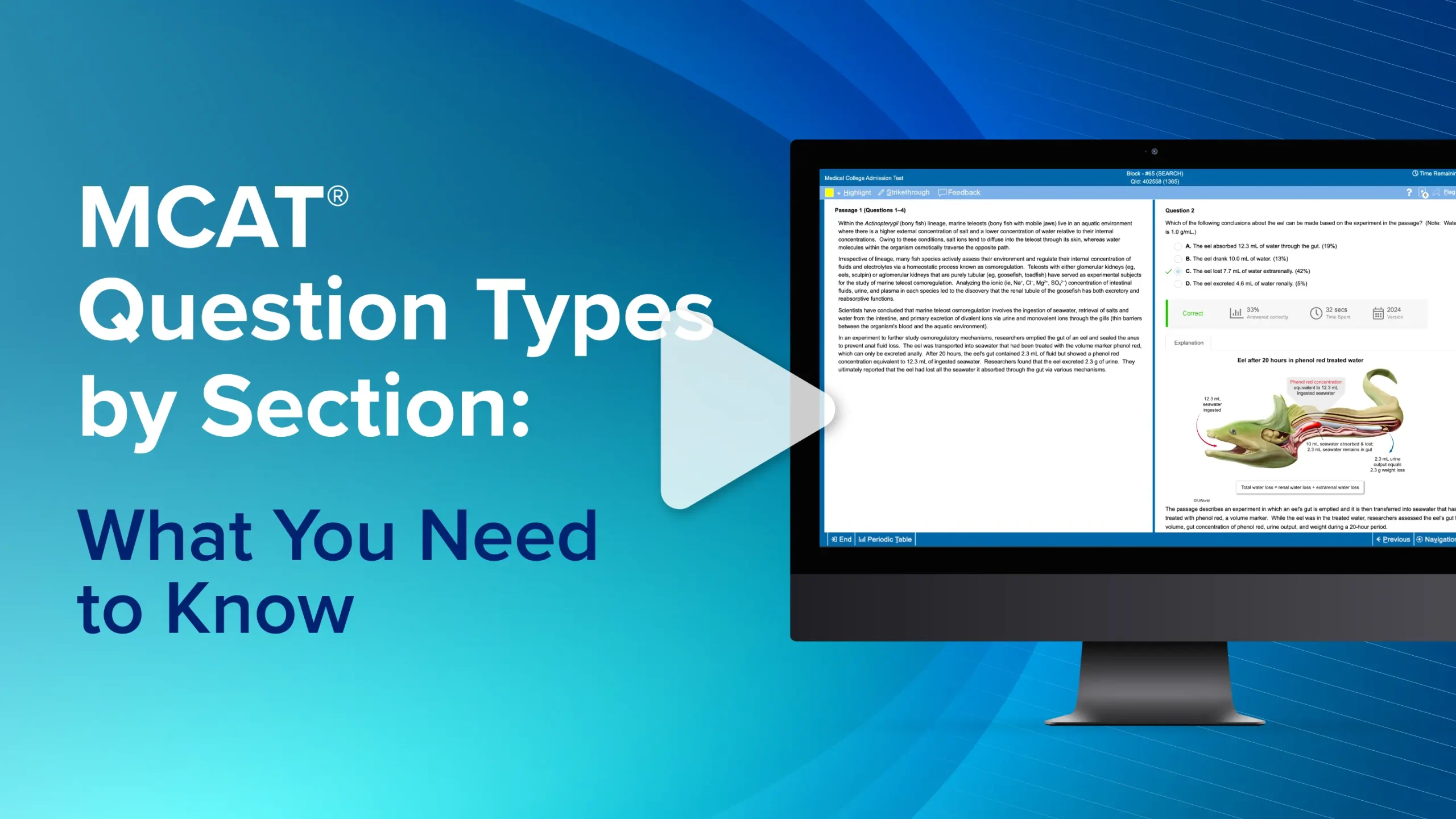
Passage-Based MCAT Questions
Passage-Based MCAT Questions
MCAT Sample Questions By Subject
Get targeted practice by visiting our subject-specific review pages.
